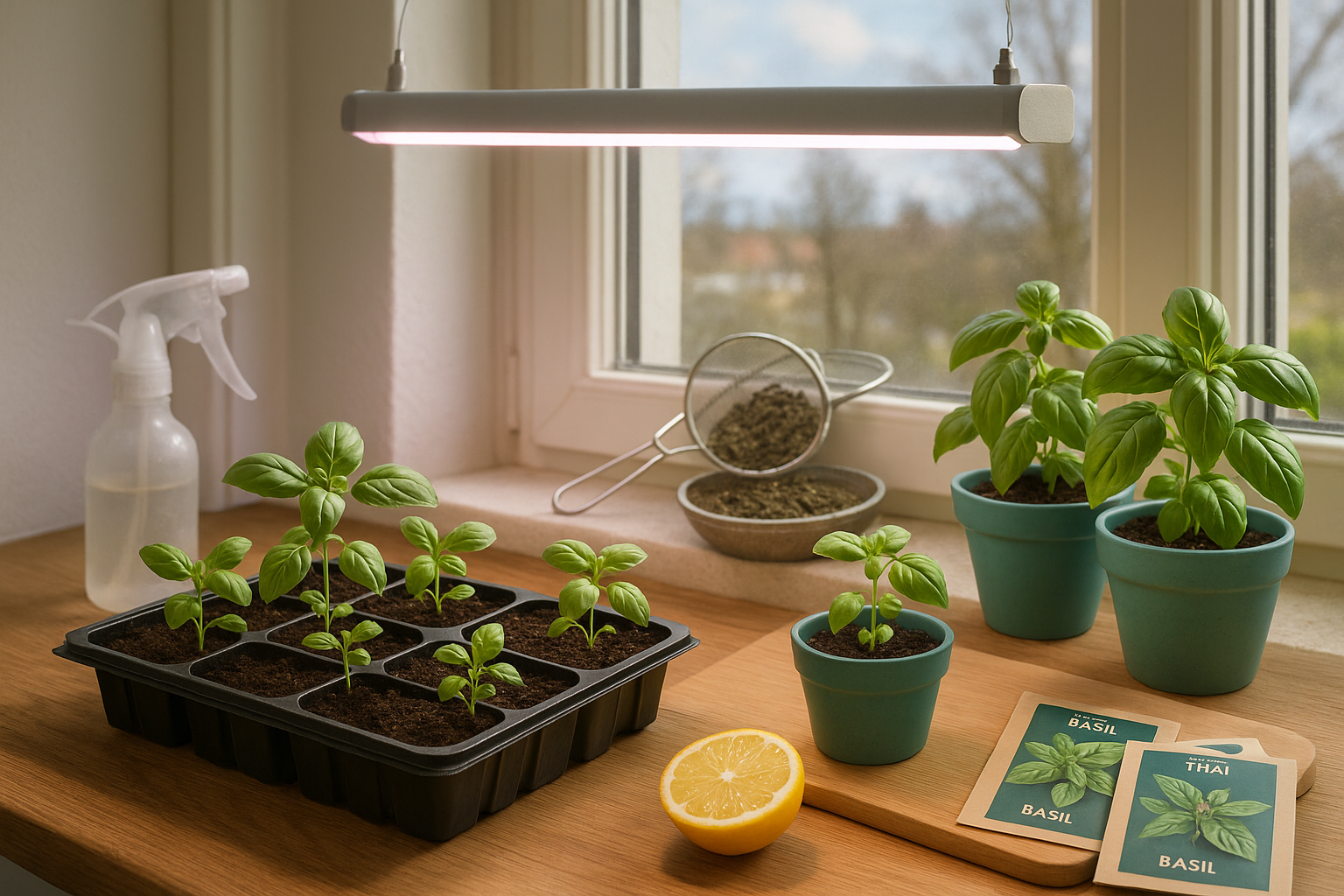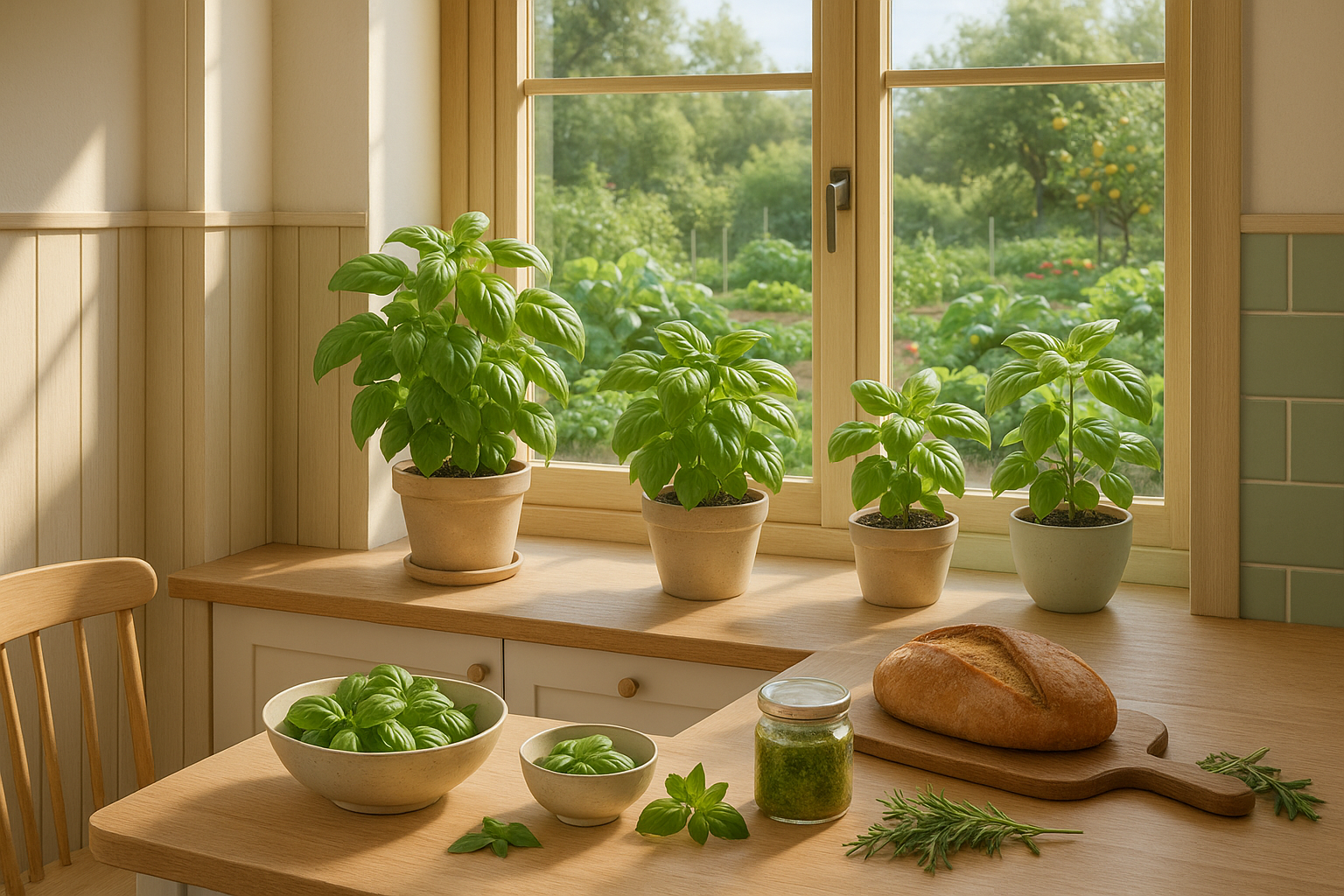Introduction
Growing basil in Sweden is an exciting way to bring the flavors of summer into your kitchen, even when the northern climate doesn’t always cooperate. Basil, with its aromatic leaves and vibrant taste, has become a staple in Swedish kitchens and gardens for everything from pasta sauces to fresh salads. However, even enthusiastic gardeners know that cultivating this Mediterranean herb in Sweden can be tricky.
The short, cool growing season, unpredictable weather, and limited sunlight often pose challenges—leaving new and experienced growers alike with slow-growing or leggy plants. Despite these hurdles, you don’t have to settle for store-bought basil.
With a few smart adjustments and insider tricks specific to Sweden’s climate, you can harvest lush, healthy basil right at home. In this blog post, you’ll find practical tips for choosing the best varieties, timing your sowing, and creating the most basil-friendly conditions indoors or out—even on a windowsill or a small balcony.
Whether you’re in Stockholm or up north in Umeå, these strategies will set you up for success, so you can enjoy fresh, homegrown basil all season long.
Understanding Sweden’s Climate for Basil
Sweden’s climate presents a unique set of opportunities and challenges for gardeners hoping to grow warmth-loving herbs like basil. The country spans several climate zones, from the mild, coastal south to the chilly, subarctic north.
In southern regions such as Skåne and Gotland, summers are comparatively longer and warmer, offering the best outdoor conditions for heat-loving plants. However, even here, daytime highs during summer might hover just above 20°C (68°F), with nights that can still feel cool—conditions that can stress basil, which thrives in consistently warm soils and air temperatures above 18°C (65°F).
In central Sweden, the growing season shortens, and nighttime chills become more frequent, while gardeners in the north often face frost risks as late as June and as early as August. No matter where you garden in Sweden, a short summer and unpredictable weather—think sudden cold snaps, cloudy weeks, or excessive rain—can make it tough for basil to flourish.
To work around this, many Swedish gardeners start basil indoors or in greenhouses, where light and warmth can be controlled. Using south-facing windowsills, heat mats, or even LED grow lights gives seedlings a vital head start.
Once outdoors, planting basil in pots or raised beds helps capture warmth, and using cloches or row covers can shelter plants from cold nights or harsh winds. These strategies don’t just keep basil alive—they help it thrive, turning Sweden’s climatic challenges into a manageable gardening adventure.
Starting Basil Indoors

Starting basil seeds indoors is a smart move in Sweden’s short growing season, as cold springs can delay outdoor planting until late May or early June. Begin sowing basil indoors about 6–8 weeks before your last expected frost, usually in mid-March or April, so the plants are strong and ready for outdoor life.
Choose high-quality basil seeds—classic Genovese is a favorite, but consider varieties like Thai or lemon basil for different flavors. Start with a seed tray or small pots filled with seed-starting mix; sow the seeds on top, gently pressing them into the surface since basil needs light to germinate, then mist with water.
Place containers on a bright windowsill with at least six hours of sunlight daily. Since Swedish sunlight can still be weak in early spring, supplement with a small grow light if possible. Keep the light just a few centimeters above the seedlings and run it for 12–16 hours daily.
Keep the soil moist but not soggy, and ensure good air circulation to prevent mold. Once seedlings have a pair of true leaves, thin them to avoid overcrowding and pinch the tops when they reach 5–8 cm high for bushier growth.
About a week before transplanting outdoors, gradually expose your basil to outdoor conditions. This “hardening off” process involves setting plants outside for a few hours each day, gradually increasing their time and sun exposure until they can handle a full day outside.
With this method, your basil will thrive in Sweden’s summer, ready for picking fresh leaves all season.
Outdoor Planting
When transplanting basil outdoors, timing is everything—especially in Sweden’s variable climate. Wait until all danger of frost has passed, which usually means after the last spring frost date in your region. This can range from early May in southern Sweden to late May or early June further north.
Basil loves warmth, so aim for soil temperatures consistently above 15°C (59°F) before moving your seedlings outside. If you’re unsure, use a soil thermometer—the extra step can save your plants from chilly setbacks.
Choosing the right spot is just as crucial. Basil thrives with at least six hours of direct sunlight daily, so pick a sunny, south-facing location if possible. However, Sweden’s winds can be surprisingly harsh and chilly, even in summer, so providing some protection—like planting near a wall or using a windbreak—can make a big difference.
When preparing your soil, mix in plenty of compost to ensure it’s rich, well-draining, and loose; basil dislikes wet, compacted earth.
If you’re debating between container or ground planting, consider your local climate quirks:
- Containers are ideal for northern Sweden or unpredictable springs—pots warm up faster, can be moved to follow the sun, or even brought indoors if the weather turns unexpectedly cold.
- Raised beds and containers also drain more effectively during Sweden’s sometimes rainy early summer.
- In southern regions with longer, warmer summers, planting directly into well-prepared garden soil works beautifully, giving basil room to sprawl and grow strong.
Many Swedish gardeners successfully combine both methods: starting basil in containers for flexibility, then transplanting into garden beds once conditions stabilize. By tuning into your local weather and microclimate, you’ll enjoy healthy basil plants all summer long.
Caring for Basil in a Cool Climate
Growing basil in Sweden’s cooler climate requires a bit of extra care, but it’s rewarding when you see those lush, green leaves flourish. Water basil consistently—keep the soil moist but never soggy, since Swedish summers can be unpredictable and waterlogged roots can kill young plants.
Add a layer of organic mulch, like straw or shredded leaves, to lock in moisture, ward off weeds, and insulate the roots against chilly nights. Because basil loves rich soil, feed it with a balanced liquid fertilizer every two to three weeks, but avoid over-fertilizing, which can weaken the flavor.
Temperature management is crucial: cover plants with fleece or use cloches when frost threatens in spring and autumn. You can also try growing basil in pots that you can move indoors or to a small greenhouse if a cold snap hits.
Pinch off the tips regularly to encourage a bushier, more productive plant—just snip above a pair of leaves, and new branches will sprout from the sides.
To keep pests at bay, check the leaves often for aphids or slugs; remove them by hand or spray with a gentle, homemade soap solution if needed. Good airflow is key to preventing fungal diseases like mildew, so avoid crowding plants too closely.
With these tips, even growers in northern climates can enjoy a healthy supply of fresh basil all season long.
Harvesting and Using Homegrown Basil

Knowing when and how to harvest basil can make all the difference in taste and plant vitality. Your basil is ready to pick once the plants have at least six sets of leaves—look for bright green, healthy leaves and avoid flowering stems for the best flavor.
To encourage regrowth, always pinch stems just above a leaf pair. This keeps the plant bushier and more productive—never strip all the leaves at once.
If you end up with more basil than you can use fresh, preserving it is easy. Try air-drying small bunches in a shaded, well-ventilated area, or freeze chopped basil in an ice cube tray with olive oil, sealing in bright flavor for months.
When it comes to the kitchen, let basil’s versatility shine:
- Add fresh leaves to a classic Swedish tomato and mozzarella smörgås.
- Enhance a creamy dill-and-basil dressing for summer salads.
- Enjoy Mediterranean favorites like caprese salad, homemade pesto, or a Greek basil-tomato sauce—all crowd-pleasers.
With a little care in harvesting and preserving, you’ll have aromatic basil ready for both Nordic and Mediterranean dishes, elevating homemade meals all season long.
Troubleshooting Common Problems
Growing basil in Sweden presents unique challenges, but with some savvy troubleshooting, you can keep your plants thriving. If you notice slow growth, it’s often due to Sweden’s short summers and cooler nights. Try moving your basil to the sunniest possible spot and use a cloche or mini greenhouse to boost warmth.
Yellow leaves are another widespread concern, usually signaling overwatering or poor drainage. Let the top inch of soil dry before watering again, and check that pots have good drainage holes.
Pests like aphids and spider mites can also wreak havoc. Gently wash leaves with a diluted soapy water solution and inspect regularly for new infestations.
For all these problems, consistency is key: monitor your plants closely for changes, and make small, steady adjustments rather than big, sudden fixes.
If outdoor conditions just aren’t working—maybe temperatures dip too low or storms are frequent—consider moving your basil indoors. Basil is a fantastic candidate for year-round indoor gardening, especially near a south-facing window or under a grow light. Indoor setups allow you to control light, warmth, and moisture with ease, ensuring a steady supply of fresh basil even during Sweden’s long, dark winters.
Whether inside or out, a little attentive care will give you lush, flavorful basil to enjoy all season.
Conclusion
Growing basil in Sweden is absolutely doable with a few simple strategies—choose a sunny spot, use quality soil, water consistently, and remember to bring plants indoors when chilly nights arrive. Don’t be afraid to try different varieties or methods, like pots, windowsills, or even vertical planters.
With some trial and error, you’ll be rewarded with fresh, aromatic basil for your favorite dishes. We’d love to hear how your basil journey goes! Share your experiences or any questions in the comments below, and inspire fellow gardeners to savor homegrown herbs, no matter the Nordic weather.
